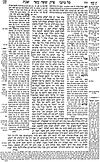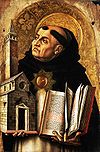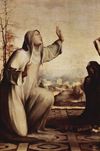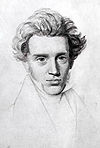- History of theology
-
This is an overview of the history of theology in Greek thought, Christianity, Judaism and Islam from the time of Jesus to the present.
Ancient Greek and Hellenistic theology
Classical Greek theology
Various forms of systematic and philosophical reflection on Ancient Greek religion and Greek mythology arose in the classical period—from Hesiod's attempts to organize the diverse materials of mythology into a unified Theogony to the more properly philosophical analysis reportedly carried out by Socrates.
Influential texts include:
- Hesiod's Theogony (c. 700 BC)
- Plato's Timaeus (c.360 BC)
- Aristotle's Metaphysics Book Lambda (c.330 BC)
Main article: Ancient Greek religion, section on TheologyHellenistic theology
Philosophical reflection on the gods, on religion, and on the origins and governance of the Universe, flourished in the Hellenistic period among both Greek- and Latin-speaking thinkers. Among the very diverse movements of Hellenistic philosophy in which theological reflection could be found were Skepticism, Cynicism, Stoicism, Epicureanism, Middle Platonism, and Neoplatonism. The Skeptics were to have a larger impact on Western reasoning than the Cynics; but this would not occur until after its having been reified during the middle years of the Roman Empire when it passed into the mainstream of Western thought.
Influential texts include:
- Cleanthes' Hymn to Zeus (3rd century BC)
- Cicero's de Natura Deorum (45 BC)
- Lucretius' de Rerum Natura (1st century BC)
- Epictetus' Enchiridion (135)
- Plotinus' Enneads (c.235 and after).
Hellenistic theology, which could be deemed to last until the suppression of the Athenian Academy in 529 by Justinian I, overlaps with early Jewish and early Christian theology (see below), and several strands of thought important particularly to early Christian thought arise within Hellenistic circles: attempts to explain the apparent caprice of the gods, Atheism, the development of monotheism, the idea of God as first cause or form of the Good, the dualism of spirit and matter in humanity, and redemption (the release of the spirit from its material prison to a higher spiritual world) through knowledge.
See also Greek mythology, Hellenistic rationalism and Ancient Greek religion – Theology
Early Jewish theology
The 1st and 2nd centuries
Two strands of Jewish theology develop in the 1st and 2nd centuries. On the one hand, there are those oral traditions of Rabbinic exegesis (Midrash) and legal discussion (Mishnah and Tosfeta) that eventually began to be written down towards the end of the 2nd century AD.
Important figures (known as Tannaim) include
- Hillel the Elder (working c.30 BC to 10 AD)
- Shamai (c. 50 BC to 30 AD)
- Gamliel I (died c. 50)
- Yohanan ben Zakkai (1st century AD)
- Gamliel II (1st century D)
- Rabbi Akiva (c. 50 to c. 135)
- Simeon bar Yohai (2nd century AD)
- Rabbi Judah haNasi (2nd century AD).
On the other hand, there is the attempt to accommodate traditional Jewish exegesis of the Jewish Scriptures and tradition with Greek philosophy—a strand of thought of which Philo (c.20 BC to 40 AD) is the best known proponent. The destruction of the Jerusalem temple in 70 AD and the dispersion of many Jews from Israel had a profound effect on Jewish Theology.
In the period of the Talmud
 A page of Talmud
A page of Talmud
In the centuries after its compilation, discussion and commentary upon the Mishnah flourished in Jewish academies in Israel and in Babylon. Collections of opinions from these discussions, known as Gemara were eventually edited together and placed with the Mishnah itself, in both Israel (around 350 AD – the Jerusalem Talmud) and Babylon (around 550 AD, with further editing in the two centuries that followed – the Babylonian Talmud).
Important figures (known as Amoraim) include
- Samuel of Nehardea (Shmuel) (c. 165-c. 257)
- Resh Lakish (born c. 200)
- Hillel, son of Gamaliel III (3rd century)
- Abba Arika (Rav) (died 247)
- Rabbi Yochanan (died c. 279)
- Abaye (278-c. 338)
- Abbahu (died c. 320)
- Ashi (352-427)
Early Christian theology
Theologies of the New Testament
The New Testament contains evidence of some of the earliest forms of reflection upon the meanings and implications of Christian faith, mostly in the form of guidance offered to Christian congregations on how to live a life consistent with their convictions – notably in the Pauline corpus and Johannine corpus.
Patristic theology
A huge quantity of theological reflection emerged in the early centuries of the Christian church – in a wide variety of genres, in a variety of contexts, and in several languages – much of it the product of attempts to discuss how Christian faith should be lived in cultures very different from the one in which it was born. So, for instance, a good deal of the Greek language literature can be read as an attempt to come to terms with Hellenistic culture. The period sees the slow emergence of orthodoxy (the idea of which seems to emerge out of the conflicts between catholic Christianity and Gnostic Christianity), the establishment of a Biblical canon, debates about the doctrine of the Trinity (most notably between the councils of Nicaea in 325 and Constantinople in 381), about Christology (most notably between the councils of Constantinople in 381 and Chalcedon in 451), about the purity of the Church (for instance in the debates surrounding the Donatists), and about grace, free will and predestination (for instance in the debate between Augustine of Hippo and Pelagius).
Influential texts and writers in the 2nd century include:
- The collection known as the Apostolic Fathers (mostly 2nd century)
- Justin Martyr (c. 100/114 – c. 162/168)
- Clement of Alexandria (died c. 215)
- Irenaeus of Lyons (c. 130 – 202)
- Various ‘Gnostic’ authors, such as Valentinius (c.100-c. 153) and Basilides (c. 117-138)
- Some of the texts commonly referred to as the New Testament apocrypha.
Influential texts and writers between c. 200 and 325 (the First Council of Nicaea) include:
- Tertullian (c. 155-230)
- Hippolytus (died 235)
- Origen (c. 182-c.251)
- Cyprian (died c. 258)
- Arius (256-336)
- Other Gnostic texts and texts from the New Testament apocrypha.
Texts from patristic authors before 325 AD are collected in the Ante-Nicene Fathers.
Influential texts and writers between 325 AD and c. 500 AD include:
- Athanasius (298-373)
- The Cappadocian Fathers (late 4th century)
- Ambrose (c. 340-397)
- Jerome (c. 347-420)
- Chrysostom (347-407)
- Augustine of Hippo (354-430)
- Cyril of Alexandria (376-444)
Texts from patristic authors after 325 AD are collected in the Nicene and Post-Nicene Fathers. Important theological debates also surrounded the various Ecumenical Councils – Nicaea in 325, Constantinople in 381, Ephesus in 431 and Chalcedon in 451 See also main articles on Patristics and Church Fathers.
Medieval Jewish theology
We may divide medieval Jewish theologians into three categories: those primarily concerned with commentary upon Talmud (who can be further divided into the Genoim and the Rishonim); those whose main interests were more in the area of philosophical theology; and those who were part of the Karaite movement that rejected Talmud.
The Geonim
The Geonim were Babylonian rabbis who taught Talmud and decided on issues on which no ruling had been rendered during the period of the Talmud. "Geon" is Hebrew for "genius."
Prominent Geonim include:
- Amram Gaon (died 875)
- Saadia Gaon (892-942)
- Hai Gaon (969-1038)
- Sherira Gaon (c. 900-c. 1000)
The Rishonim
The Rishonim were the leading rabbis between approximately 1250 to 1550, that is in the era before the writing of the Shulkhan Arukh by Rabbi Yosef Karo, which is considered the most authoritative compilation of Jewish law since the Talmud.
Prominent Rishonim include:
- Solomon ben Isaac (Rashi) (1040-1105)
- Isaac Alfasi (1013-1103)
- Abraham Ben Mair ibn Ezra (Abenezra) (c. 1092-1167)
- Abraham ben David of Posquières (Rabad) (c. 1125-1198)
- Moshe ben Nahman (Nahmnanides) (1194-c. 1270)
- Ashur ben Jehiel (Rosh) (1250/1259-1328)
Medieval Jewish philosophy
- Solomon ibn Gabirol (Avicdebron) (c.1021-1070)
- Bahya ibn Paquda (11th century)
- Moses ibn Ezra (c. 1070-after 1138)
- Moshe ben Maimon (Maimonides) (1135-1204)
- Levi ben Gershon (Gersonides) (1288-1334)
- Hasdai Crescas (1340-1410)
Karaite theologians
- Benjamin Nahawandi (late 8th century – early 9th century)
- Jacob ben Reuben (11th century)
- Aaron ben Joseph (c. 1260-1320)
- Aaron ben Elijah, the younger (c. 1300-1369)
- Elijah ben Moses ben Menahem (Bashyazi) (c. 1420-c.1490)
Medieval Christian theology
Byzantine theology
While the Western Roman Empire declined and fell, the Eastern Roman Empire, centred on Constantinople, remained standing until 1453, and was the home of a wide range of theological activity that was seen as standing in strong continuity with the theology of the Patristic period; indeed the division between Patristic and Byzantine theology would not be recognised by many Orthodox theologians and historians.
Mystical theology
- Pseudo-Dionysius the Areopagite (working c. 500)
- Symeon the New Theologian (949-1022)
- Gregory Palamas (1296-1359)
Christological controversy after Chalcedon
- Severus of Antioch (c. 465-518)
- Leontius of Jerusalem (working 538-544)
- Maximus the Confessor (c. 580-682)
- Catholic–Orthodox theological differences
Iconoclasts and iconophiles
- Patriarch Germanus I of Constantinople (patriarch 715-730)
- John of Damascus (676-749)
- Theodore the Studite (c. 758-c.826)
Western theology
Before the Carolingian Empire
When the Western Roman Empire fragmented under the impact of various 'barbarian' invasions, the Empire-wide intellectual culture that had underpinned late Patristic theology had its interconnections cut. Theology tended to become more localised, more diverse, more fragmented. The classically-clothed Christianity preserved in Italy by men like Boethius and Cassiodorus was different from the vigorous Frankish Christianity documented by Gregory of Tours which was different again from the Christianity that flourished in Ireland and Northumbria in the 7th and 8th centuries. Throughout this period, theology tended to be a more monastic affair, flourishing in monastic havens where the conditions and resources for theological learning could be maintained.
Important writers include:
- Caesarius of Arles (c. 468-542)
- Boethius (480-524)
- Cassiodorus (c. 480-c. 585)
- Pope Gregory I (c. 540-604)
- Isidore of Seville (c. 560-636)
- Bede (672-736)
Theology in the time of Charlemagne
Both because it made communication between different Christian centres easier, and because there was a concerted effort by its rulers to encourage educational and religious reforms and to develop greater uniformity in Christian thought and practice across their territories, the establishment of the Carolingian Empire saw an explosion of theological inquiry, and theological controversy. Controversy flared, for instance, around 'Spanish Adoptionism, around the views on predestination of Gottschalk, or around the eucharistic views of Ratramnus.
Important writers include:
- Alcuin (c. 735-804)
- The Spanish Adoptionists Felix of Urgel and Elipandus of Toledo (late 8th century)
- Claudius of Turin (?-839)
- Rabanus Maurus (c. 780-856)
- Radbertus (c. 790-865)
- Ratramnus (died c.868)
- Hincmar (806-882)
- Gottschalk (c. 808-c. 867)
- Johannes Scotus Eriugena (c. 815-877)
Before Scholasticism
With the division and decline of the Carolingian Empire, notable theological activity was preserved in some of the Cathedral schools that had begun to rise to prominence under it – for instance at Auxerre in the 9th century or Chartres in the 11th. Intellectual influences from the Arabic world (including works of classical authors preserved by Islamic scholars) percolated into the Christian West via Spain, influencing such theologians as Gerbert of Aurillac, who went on to become Pope Sylvester II and mentor to Otto III. (Otto was the fourth ruler of the Germanic Ottonian Holy Roman Empire, successor to the Carolingian Empire). With hindsight, one might say that a new note was struck when a controversy about the meaning of the eucharist blew up around Berengar of Tours in the 11th century: hints of a new confidence in the intellectual investigation of the faith that perhaps foreshadowed the explosion of theological argument that was to take place in the 12th century.
Notable authors include:
- Heiric of Auxerre (c. 835-887)
- Remigius of Auxerre (c. 841-908)
- Gerbert of Aurillac (c. 950-1003)
- Fulbert of Chartres (died 1028)
- Berengar of Tours (c. 999-1088)
- Lanfranc (died 1089)
Early Scholasticism and its contemporaries
Anselm of Canterbury is sometimes misleadingly called the 'Father of Scholasticism' because of the prominent place that reason has in his theology; instead of establishing his points by appeal to authority, he presents arguments to demonstrate why it is that the things he believes on authority must be so. His particular approach, however, was not very influential in his time, and he kept his distance from the Cathedral Schools. We should look instead to the production of the gloss on Scripture associated with Anselm of Laon, the rise to prominence of dialectic (middle subject of the medieval trivium) in the work of Abelard, and the production by Peter Lombard of a collection of Sentences or opinions of the Church Fathers and other authorities. Scholasticism proper can be thought of as the kind of theology that emerges when, in the Cathedral schools and their successors, the tools of dialectic are pressed into use to comment upon, explain, and develop the gloss and the sentences.
Notable authors include:
- Anselm of Canterbury (1033/1034-1109)
- Anselm of Laon (died 1117)
- Hugh of St Victor (1078-1151)
- Peter Abelard (1079-1142)
- Bernard of Clairvaux (1090-1153)
- Hildegard of Bingen (1098-1179)
- Peter Lombard (c. 1100-1160)
- Joachim of Fiore (c. 1135-1202)
High Scholasticism and its contemporaries
The 13th century saw the attempted suppression of various groups perceived as heterodox, such as the Cathars and Waldensians and the associated rise of the mendicant orders (notably the Franciscans and Dominicans), in part intended as a form of orthodox alternative to the heretical groups. Those two orders quickly became contexts for some of the most intense scholatsic theologizing, producing such 'high scholastic' theologians as Alexander of Hales (Franciscan) and Thomas Aquinas (Dominican), or the rather less obviously scholastic Bonaventure (Franciscan). The century also saw a flourishing of mystical theology, with women such as Mechthild of Magdeburg playing a prominent role. In addition, the century can be seen as period in which the study of natural philosophy that could anachronistically be called 'science' began once again to flourish in theological soil, in the hands of such men as Robert Grosseteste and Roger Bacon.
Notable authors include:
- Saint Dominic (1170-1221)
- Robert Grosseteste (c. 1175-1253)
- Francis of Assisi (1182-1226)
- Alexander of Hales (died 1245)
- Mechthild of Magdeburg (1210-1285)
- Roger Bacon (1214-1294)
- Bonaventure (1221-1274)
- Thomas Aquinas (1225-1274)
- Angela of Foligno (1248-1309)
Late Scholasticism and its contemporaries
Scholastic theology continued to develop as the 13th century gave way to the fourteenth, becoming ever more complex and subtle in its distinctions and arguments. The 14th century saw in particular the rise to dominance of the nominalist or voluntarist theologies of men like William of Ockham. The 14th century was also a time in which movements of widely varying character worked for the reform of the institutional church, such as conciliarism, Lollardy and the Hussites. Spiritual movements such as the Devotio Moderna also flourished.
Notable authors include:
- Meister Eckhart (1260-1328)
- Duns Scotus (1266-1308)
- Marsilius of Padua (1270-1342)
- William of Ockham (c. 1285-1349)
- John Wycliffe (c. 1320-1384)
- Julian of Norwich (1342-1413)
- Geert Groote (1340-1384)
- Catherine of Siena (1347-1380)
- Jean Gerson (1363-1429)
- Jan Hus (c. 1369-1415)
- Thomas a Kempis (1380-1471)
See also Scholasticism
Islamic theology
This article is part of the series: Islam  See also: Islamic theology and Kalam
See also: Islamic theology and KalamThe beginnings of Kalam
Main article: Qadr (doctrine)Islamic theology or Kalam, in the sense of ordered, rational reflection upon Allah and his Qur'an, is commonly held to begin at the end of the 7th century – the 1st century A.H. – with debates about divine and human freedom.
The Qadariyyah were those who defended a fairly strong view of human freedom, and included
- Ma'bad ibn Khalid al-Juhani (d.699)
- Ghaylan ibn Marwan al Dimashqi (d.749)
'The Jabriyyah were their opponents, and included
- Jahm ibn Safwan (d.745)
Mu'tazilah
The Qadariyyah evolved into Mu‘tazilah which for some time was the dominant form of kalam, imposed as official orthodoxy under the Abbasid dynasty, until the accession of Al-Mutawakkil in 847, after which it was suppressed. For the five principal doctrines of Mutazilism, see the main article. Prominent Mutazilite theologians include:
- Wasil ibn Ata (c. 700-748)
- Abu Huthail al-‘Allaf (c. 750–c.849)
- Ibrahim al-Nazzam (died c. 846)
- al-Jahiz (c. 776-869)
- al-Jubba'i (died 916)
- al-Qadi Abdul Jabbar (died 1025)
- al-Mawardi (974-1058)
- Zamakhshari (died 1144)
Ash'aryah
From the late 10th century onwards, Mutazilite kalam, opposition to which had hitherto been almost indistinguishable from opposition to kalam itself, found a new opponent within kalam: Ash'ari kalam. Asharite kalam rose to become the dominant form of Islamic kalam, and helped distinguish kalam from falasafa—from philosophy (a distinction which is less clear when considering Mutazilite thought).
Prominent Asharites include:
File:Al-Ghazali.jpgAl-Ghazali- Abu l'Hasan al-Ashari (died 945)
- Abu Bakr al-Baqillani (died 1013)
- Abu'l Ma'ali al-Juwayni (1028-1085)
- Al-Ghazali (died 1111)
- Fakhr al-Din Razi (died 1209)
Note should also be taken of the variant of Asharism known as Maturidism. Prominent Maturidi authors include:
- Abu Mansur Al Maturidi (died 944)
- al-Nasafi (died 1114)
Falasafa (Islamic philosophy)
Whilst the boundaries are sometimes rather porous, scholars of Islamic thought often make a distinction between Falasafa (Islamic philosophy) and Kalam (Islamic theology). Prominent writers normally held to stand on the Falasafa side of the divide include:
- Al-Kindī (died 873)
- Al-Razi (865-925)
- Al-Farabi (870-950)
- Ibn Miskawayh (932-1030)
- Ibn Sina (Latinised form: Avicenna) (980-1037)
- Ibn Hazm (994-1069)
- Ibn Bajjah (died 1138)
- Ibn Tufail (c. 1110-1185)
- Ibn Rushd (Latinised form: Averroes) (1126-1198)
Reformation and Counter-Reformation Christian theology
The Renaissance yielded scholars the ability to read the scriptures in their original languages and this in part stimulated the Reformation, a theological movement that protested the outlawing of their faith at the Second Diet of Speyer. Its main themes were Justification by faith, the Bible as the only source of Christian teaching, and the Priesthood of all believers, and. Important figures include Luther, Melanchthon, Bucer, Zwingli, Calvin, and the Anabaptists. Calvinist theology was developed by successors such as Beza, the English Puritans and Turretin. Lutheran theology entered a period of doctrinal unity with the adoption of the Book of Concord and preserved it through the work of theologians such as Chemnitz and Gerhard.
The Roman Catholic Counter-Reformation spearheaded by the Jesuits under Ignatius Loyola took their theology from the decisions of the Council of Trent and developed Second Scholasticism, which they pitted against Lutheran Scholasticism. The overall result of the Reformation was to highlight distinctions of belief that had previously co-existed uneasily.
The Fall of Constantinople in the East, 1453, led to a significant shift of gravity to the rising state of Russia, the "Third Rome". The Renaissance stimulated a program of reforms by patriarchs of prayer books. A movement called the "Old Believers" consequently resulted and influenced Russian Orthodox Theology in the direction of conservatism and Erastianism.
Modern Christian theology
After the Reformation protestant groups continued to splinter, leading to a range of new theologies. The "Enthusiasts" were so named because of their emotional zeal. These included the Methodists, the Quakers and Baptists. Another group sought to reconcile Christian faith with "Modern" ideas, sometimes causing them to reject beliefs they considered to be illogical, including the Nicene creed and Chalcedonian Creed. these included Unitarians and Universalists. A major issue for Protestants became the degree to which Man contributes to his salvation. The debate is often viewied as synergism versus monergism, though the labels Calvinist and Arminian are more frequently used, referring to the conclusion of the Synod of Dort.
The 19th century saw the rise of biblical criticism, new knowledge of religious diversity in other continents and above all the growth of science. This led many church men to espouse a form of Deism. This, along with concepts such as the brotherhood of man and a rejection of miracles led to what is called "Classical liberalism". Immensely influential in its day, classic liberalism suffered badly as a result of the two world wars and fell prey to the criticisms of postmodernism.
Vladimir Lossky is a famous Eastern Orthodox theologian writing in the 20th century for the Greek church.
Postmodern theology
Postmodern theology seeks to respond to the challenges of post modern and deconstructionist thought, and has included the death of God movement, Process Theology, Feminist theology and Queer Theology and most importantly Neo-orthodox Theology. Karl Barth, Rudolf Bultmann and Reinhold Niebuhr were Neo-Orthodoxies main representatives. In particular Barth labeled his Theology "Dialectical Theology", a reference to existentialism.
The predominance of Classic Liberalism resulted in many reactionary movements amongst conservative believers. Evangelical theology, Pentecostal or Renewal theology and Fundamentalist theology, often combined with Dispensationalism, all moved from the fringe into the academy. Marxism stimulated the significant rise of Liberation Theology which can be interpreted as a rejection of Academic Theology that fails to challenge the establishment and help the poor.
From the late 19th century to the early twentieth groups established themselves that derived many of their beliefs from Protestant evangelical groups but significantly differed in doctrine. These include the Jehovah's Witnesses, the Latter Day Saints and others. Many of these groups use the Protestant version of the bible and typically interpret it in a fundamentalist fashion, adding, however, special prophecy or scriptures, and typically denying the trinity and the full deity of Jesus Christ.
Ecumenical Theology sought to discover a common consensus on theological matters that could bring the many Christian denominations together. As a movement it was successful in helping to provide a basis for the establishment of the World Council of Churches and for some reconciliation between more established denominations. But ecumenical theology was nearly always the concern of liberal theologians, especially Protestant ones. The movement for ecumenism was opposed especially by fundamentalists and viewed as flawed by many neo-orthodox and confessional Lutheran theologians.
The pattern of challenge from a changing world, liberal response from official representatives and orthodox backlash from conservatives is found also in the history of Islam and Judaism. Reform Judaism represents a liberal interpretation as against Orthodox Judaism, and moderate or Liberal Islam continues to be theologically distinct from Islamic Fundamentalism, notably its Wahabi and Deobandi Schools.
References
History of religions Major groups Historical Celtic · Germanic · Illyro-thracian · Greek · Hellenism (Gnosticism · Neoplatonism) · Roman · Slavic · Vedic HinduismCategories:
Wikimedia Foundation. 2010.













